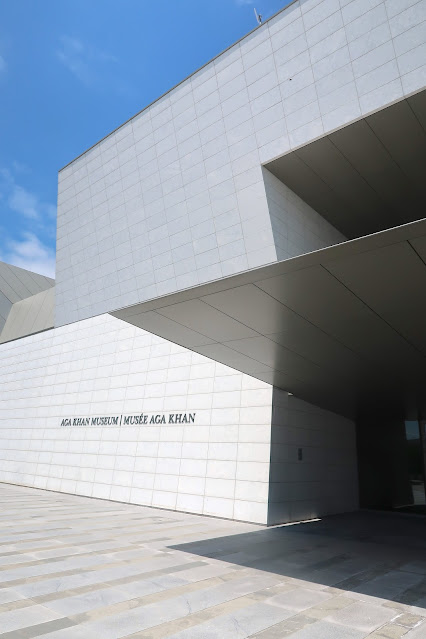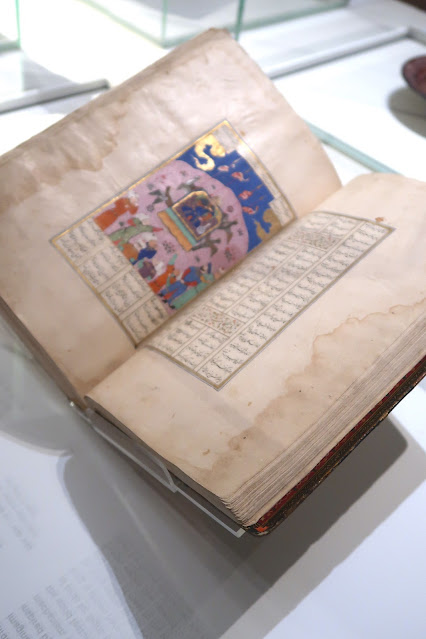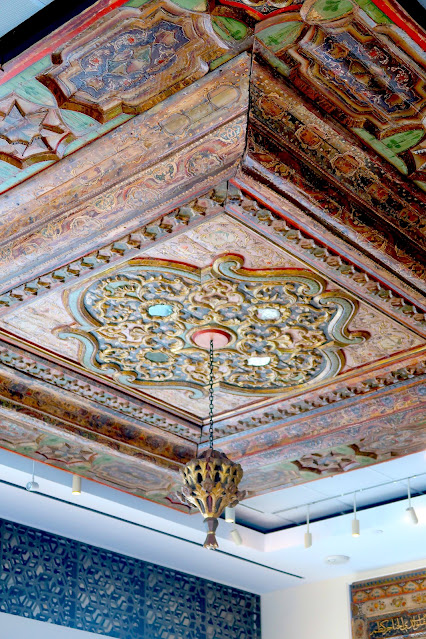North America’s first museum dedicated to Islamic art and culture, The Aga Khan Museum offers many visitors a window into worlds unknown or unfamiliar: the artistic, intellectual, and scientific contributions of Muslim civilizations to world heritage across the centuries. Created as a pillar for global pluralism, the Museum’s permanent collection of more than 1,000 artefacts includes masterpieces that reflect a broad range of artistic styles and materials, including portraits, textiles, miniatures, manuscripts, ceramics, tiles, medical texts, books and musical instruments that represent more than ten centuries of human history from a geographic area stretching from Spain, Sicily, Africa, the Balkans, Central Asia, China, India, and Southeast Asia.
Tucked away on a bright sunny corner of the museum's main floor is Diwan, which means 'spiritual room', the museum's elegant and refined restaurant, handsomely decorated with original panels from an 18th-century Damascus Mosque bought at auction in London by the Aga Khan. Few museums offer as beautiful a dining space as the one at the Aga Khan Museum, a culinary destination in its own right, showcasing Chef McEwan and executive chef Shen Ousmand’s innovative approaches to the great cuisines of Turkey, Iran, North Africa, Central Asia and the Indian subcontinent that stand up to the museum's collections, with their broad symphony of summer flavours.
Mezes include Sweet Onion Bhaji, Lamb or Vegetable Samosas, and Warm Halloumi with Vine Leaves, grape molasses, pine nuts, zaatar and pomegranate seeds. Tempting entrées include Moroccan Spiced Lamb Shank, Green Harissa Shrimp Kebab with Persian Rice, Dill Labneh and Shirazi Salad, and outstanding Palak Paneer with spinach purée, crispy onion, pomegranate seeds, fresh dill and edible silver leaf with garlic naan. They even serve a Diwan Lamb Burger that's served with chipotle aioli, onion marmalade, whipped feta cheese and choice of Zaatar Frites or Sabzi Salad. With two prix fixe menus and an a la carte menu from which to choose, and a fine cocktail and wine list, Diwan is open for lunch every day but Monday, and dinner Friday and Saturdays during the summer.
that date from the early Islamic periods through to the 17th-century
12th-century Iranian earthenware Haft-Sin dish with lustre painting
11th-century Egyptian Bowl with Hare
15th-century Pharmacy Jars from Syria
Spanish Manuscript of the Kitab al-Jaghrafyia (Book of Geography)
followed by one of the earliest versions of the famous Thousand and One Nights,
thought to have been adapted from a Persian source c 1235
mythical prehistory, and is one of the longest epics ever composed
that feature priceless treasures from Prince Shah Karim al-Husseini, Aga Khan IV
features Qu'ranic verses about forgiveness and protection
for the sensational quality of the cuisine and warm professionalism of the servers
A jewel box of a restaurant with an original ceiling medallion and wall panels from
an 18th-century Damascus Mosque bought at auction in London by the Aga Khan
Executive Chef Shen Ousmand of Diwan
(photo by Jiali Ou)
Thyme Lemonade
Finely sliced onion smothered in a simple,
fragrantly spiced batter and fried to crispy perfection - Yum
pepperoncini, shallots, garlic and halloumi cheese with a tomato dipping sauce
Palak Paneer with spinach purée, crispy onion, and garnished with pomegranate seeds
fresh dill and edible silver leaf with garlic naan - outstandingly delicious
Fatteh Baba Ghanouj
Serves 8-10
Recipe courtesy of chef Shen Ousmand, Diwan
Dukkha:
1/4 cup plus 2 tbsp chopped walnuts
1/4 cup slivered almonds
3 tbsp shelled pistachios
1/4 cup sesame seeds
1 tbsp coriander seeds
1 tbsp cumin seeds
1 tsp black pepper
1/2 tsp salt
Baba Ghanouj:
2 large eggplants
1/4 cup tahini
1 lemon, juiced
3 garlic cloves, minced
1/4 tsp ground cumin
Kosher salt, to taste
2 tbsp flat-leaf parsley, chopped
Olive oil for garnish
Fatteh:
1 cup plain Greek yogurt
1/2 cup fresh mint leaves, finely chopped plus more for garnish
2 cups canned chickpeas, rinsed and drained
1/4 cup harissa sauce
Hot chili powder or cayenne, to taste
Kosher salt and pepper, to taste
Canola oil or vegetable oil for frying
4 whole thick pitas or naan, sliced into quarters
4 whole the Arabic pitas, sliced into eighths
Sumac and zaatar, to taste
For the dukkah: in a skillet over medium heat, toast walnuts, almonds and pistachios until fragrant and slightly golden. Let cool for 5 minutes, then place toasted nuts in a food processor or spice grinder and pulse until it achieves a texture similar to bread crumbs. Store in an airtight container. (Makes 1 cup)
For the Fatteh: In a small bowl, whisk together the yogurt and chopped mint, then set aside. In another mixing bowl, toss together the chickpeas and harissa sauce. Add chili pepper or cayenne for added heat. Season with salt and pepper, then set aside. In a heavy bottomed pot or deep skillet over medium-high heat, add enough oil to reach and least 1/2-inch deep. In small batches, fry pita slices until crispy and golden brown, about 5-10 seconds per side. Remove from the oil and place of plate lined with paper towel. Repeat with remaining pitas. In a large mixing bowl, toss the fried pitas with sumac, zaatar, salt and pepper until lightly coated, then set aside.
For the Baba Ghanouj: Adjust oven rack to central position and turn on the broiler. Line a baking sheet with aluminum foil. Poke the eggplants all around with a fork to allow steam to escape while roasting, then broil, turning occasionally for 50-60 minutes, until the eggplants have become very soft all over and charred on all sides. Remove from the heat and allow to cool for 15 minutes, or until cool enough to handle.
Meanwhile, in a medium sized mixing bowl, whisk together tahini, lemon juice, garlic, cumin and salt, then set aside. Slice the cooled eggplants in half lengthwise, and let any excess liquid drain out. Using a spoon, scoop out the flesh and transfer to the bowl with the tahini mixture. Discard the skins and excess liquid. Mash the eggplant together with the tahini mixture until a smooth but slightly chunky texture is achieved. Allow to cool to room temperature before stirring in the parsley and garnishing with a drizzle of olive oil. Serve immediately or refrigerate in an airtight container for up to 5 days.
Assemble the dish by first arranging slices of grilled pita in an even layer in a large serving platter, then place dollops of Baba Ghanouj and mint yogurt around the pitas. Sprinkle chickpeas on top. Garnish liberally with dukkah, chopped parsley and more mint and serve immediately.





























No comments:
Post a Comment